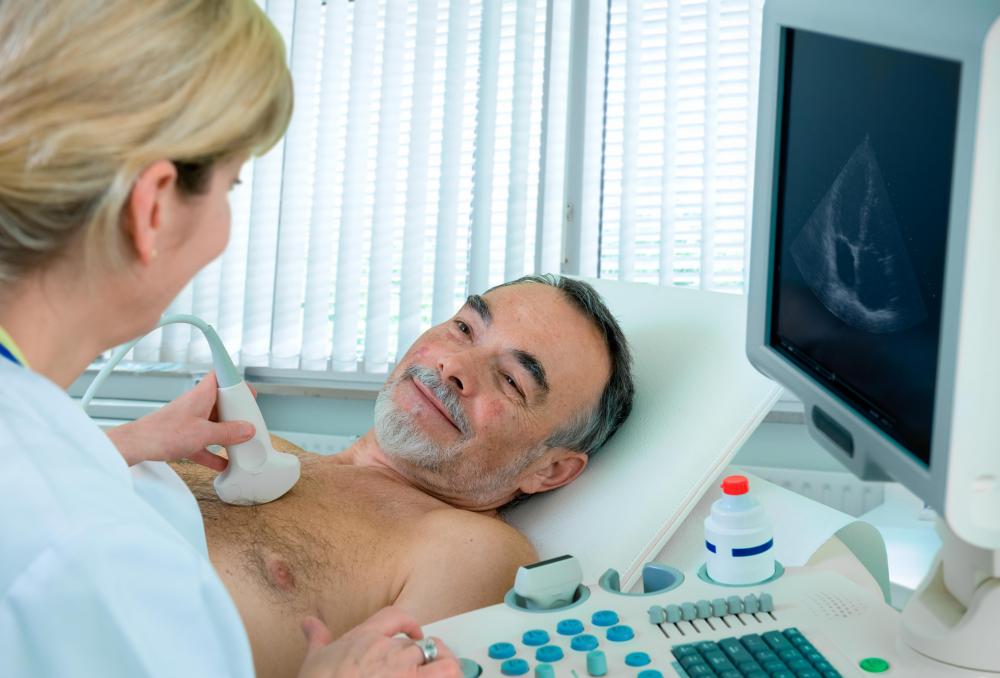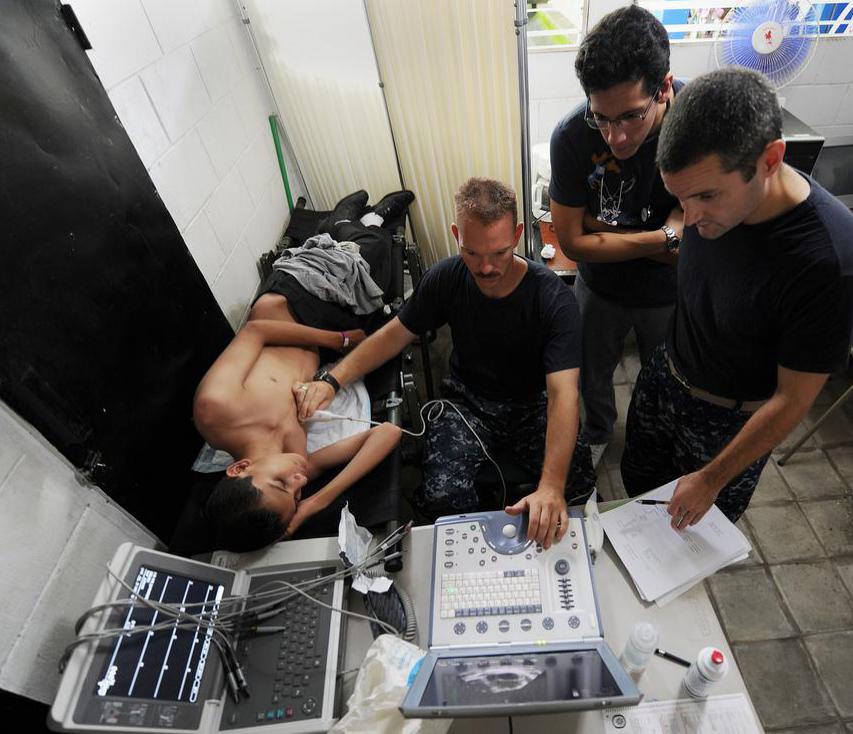At TheHealthBoard, we're committed to delivering accurate, trustworthy information. Our expert-authored content is rigorously fact-checked and sourced from credible authorities. Discover how we uphold the highest standards in providing you with reliable knowledge.
What Is a Bubble Echocardiogram?
A bubble echocardiogram is a procedure which is designed to give a doctor an idea of how well someone's heart is functioning. This medical test may be ordered for a patient who appears to be experiencing problems related to the physical function of the heart, such as leaky valves or an oversized heart. Very few risks are associated with a bubble echocardiogram, and the procedure is virtually painless. A patient's doctor or cardiologist will usually discuss the procedure and its possible outcomes with a patient before the bubble echocardiogram is performed.
In a traditional echocardiogram, the patient's heart is ultrasounded to create a picture of the heart, allowing medical professionals to assess the condition of the heart without the need for invasive surgery. The test is typically performed by an ultrasound technician, who may record the procedure or print out specific images which may be of interest to a physician. In a bubble echocardiogram, the echocardiogram is performed, and then a bubble of saline is injected into a vein in the arm.

As the saline moves through the heart, the ultrasound technician follows it. The saline makes certain heart functions more visible, highlighting problems in the left ventricle, the major pumping area of the heart, along with issues with the valves. The saline ultimately dissipates harmlessly into the blood, and is eventually expressed by the body along with other waste materials.

From start to finish, a bubble echocardiogram usually takes around half an hour. The patient is usually asked to remove his or her top so that a clearer image can be generated, and the procedure starts with the application of conductive gel to the area of interest. This gel helps the ultrasound machine generate a clearer picture. Some discomfort is associated with the injection of saline, but beyond that, a bubble echocardiogram should not cause pain or complications for the patient.

Having an imaging study of your heart is not something to be immediately concerned about, as results can be quite varied, and you have a number of options when it comes to responding to test results. It is important to stay relaxed and calm during such procedures, even if you are worried, to ensure that tension does not not interfere with test results. Your doctor may take a day or two to review the results of the bubble echocardiogram before discussing them with you.
Does a Bubble Echocardiogram Hurt?

The injection of the saline can be slightly painful, but the rest of the procedure doesn’t hurt. Relaxing your muscles, distracting yourself with a book or video, or having someone you trust come along can help reduce the discomfort. Making sure you’re well-hydrated before the test may also make the injection easier.
Are There Any Bubble Echocardiogram Side Effects?
Some people notice a strange taste in their mouths due to the saline, and the injection area may feel slightly irritated after the test.
A bubble echocardiogram is considered a very safe test. Ultrasound imaging carries no known risks. There is a very slight chance of the air bubbles injected into the bloodstream causing a stroke or mini-stroke, but the risk is extremely low because air bubbles that cause such problems are almost always much larger than the ones used in the test.
How Long Does a Bubble Echocardiogram Take?
The procedure usually takes about half an hour. If your cardiologist is present during the test he or she can interpret the results immediately; otherwise, it may take a day or two for you to receive the results. The test itself is usually performed by an ultrasound technician who is specially trained to perform various types of ultrasonography but does not interpret the results.
How Should You Prepare for a Bubble Echocardiogram?
Unless your doctor instructs you otherwise, you can eat and drink normally before the test. Wear comfortable clothing and choose a top that is easy to remove. You can resume your normal activities (including driving) as soon as your appointment is over, so you don’t need to arrange a ride.
What Does a Bubble Echocardiogram Look for?
A bubble echocardiogram is often performed when a cardiologist suspects that a patient has a condition called patent foramen ovale or one called atrial septal defect. Both PFO and ASD can be summed up as a hole in the heart. Humans are born with such a hole, but it usually closes up naturally within a few weeks of birth, meaning that there is no communication between the left and right sides of the heart. If PFO persists into adulthood, it can raise the risk of strokes and heart attacks.
If you have a PFO or ASD, the test will reveal it because the air bubbles will enter the right side of your heart and cross through the opening into the left side. The bubbles will eventually be absorbed by your lungs.
Bubble echocardiograms are also used to detect pulmonary arterio-venous malformations, which are small holes in blood vessels in the lungs, and enlarged blood vessels in the lungs (which can be caused by liver disease).
What Symptoms Might Prompt a Bubble Echocardiogram?
Many people who have PFO show no symptoms, but if you are experiencing breathlessness, fatigue, or neurological issues such as migraines or mini-strokes, your doctor might recommend a bubble echocardiogram. One may also be recommended as part of a larger testing regime if your doctor suspects you have liver disease.
AS FEATURED ON:
AS FEATURED ON:














Discussion Comments
@anon28009 - Regarding to feeling faint when you get too warm: have your thyroid, parathyroid, and, if necessary thereafter, the pituitary gland checked out, but especially start with thyroid. I've got thyroid tumors, but my regular thyroid panel has come out normal, although they are prepping to do a thyroid uptake scan, as they think my nodules appear cancerous (solid, and, multiplying, and, complex - cystic and solid complex - and, these are cancerous features. I'm already a cancer patient, bu, my CEA levels jumped up -- all the more reason to rule in/rule out thyroid cancer, via the thyroid uptake scan. The thyroid can cause problems regulating temperature. I'm very temperature sensitive, and I will often feel very hot to touch, but my actual internal temp is very low, which is hazardous to one's body. And thyroid problems can lead to cardiac problems, as well, and very serious heart problems, depending on what's going on with your whole symptoms.
Try keeping a journal of input/output of foods/liquids - stool and pee, and, body temp, and any other symptoms, like palpitations (ventricular events), and, tachycardia, low/high BP, cardiac decompensation - feeling very lightheaded, nausea, vomiting, BM, pain, pale, puke, etc. All serious cardio symptoms should be checked out in an ER, if you can, and follow up ASAP with a cardio and/or your primary care physician.
I'm also being sent to an endocrinologist, regarding the thyroid tumors - with a provisional diagnosis of thyroid toxicosis with ectopic nodule(s) and mention of thyroid crisis/storm, and that is serious! Thank God for my new Internal medicine doctor who is from the Philippines. Doctors and nurses in Philippines are more intensely trained - and, my doctor is a Diplomate (not diplomat), which means he is always continuing his education, continuous learning. I finally lucked into a great PCP and his office!
As for the bubble test, I had mine done, because I have been having problems with TIA symptoms, and, I too was told the bubble test will look for holes in the heart. It was easy as could be, and was the first time I had one done. The place where my echo was done, their protocols include the bubble test, and I'm glad they did it; it is more thorough, and therefore diagnostic.
Good luck to all of you, and if anyone tries to just blame it on stress, especially if you're a female, don't just believe that. You know your body, you can keep a journal, which is so helpful to you and your medical providers, and, keep searching for the right diagnosis, as we all deserve the best care possible.
Thank you. -- Jo
Re: agitated normal saline. How much do we need to inject and how much it will cost ? Do we require a cardiologist on site to perform a bubble study?
How do you feel after a bubble test? Can I go to work the next day?
I ad a bubble test today and did not have to cough or bear down and she said she had enough at rest. What does that mean?
Is there a CPT code used for the Bubble Study, separate from the normal echo codes?
I've had weakness, chest discomfort, shortness of breath and fluid retention in my abdomen for several years on and off.
I had the flu or something like it in 2005. I recovered, but about a week after the flu I developed a dry cough and then chest pains and shortness of breath. I went to the ER and they said it wasn't a heart attack and sent me home. I was weak and short of breath for months.
I cannot fly in an airplane anymore without getting chest pain and every time I start an aerobic exercise program like the treadmill I get weak and start to retain fluid after a few days of aerobics.
I've had multiple echos and stress echos, even a cardiac cath and a CT angio but they cannot find the problem. Can anyone relate to this? It's so frustrating.
So I had a bubble echo today and it was the first time. They were investigating the results of other cardiology testing that was done during pregnancy.
I had three abnormal EKGs when I was pregnant and that was cause for concern. Apparently I have a hole in my septum. My question is, if a lot of bubbles leaked to the other side, do I need to be more concerned? About half or more of the bubbles went to the other side.
I had a echo bubble test yesterday. The tech could not see bubble. Injected three times. What would cause that?
is there anything special you need to do before taking an echo bubble study?
yes you can eat and drink before the test. I had the echo ultrasound today, but they could not get a vein for the bubble test.
i am having a echo and bubble study. I have chest pain have blacked out headaches, my feet are blue and lost all feeling in my toes. this is the first time I've seen a cardiovascular doctor. this has gone on for a year, and my regular doctor kept saying stress until he saw my legs and feet.
I had a bubble test done and it was painless (thanks to my super awesome nurse who was great at putting in the IV). They inject air into saline solution so there are a million little bubbles. The solution looks opaque rather than clear.
That is injected into a vein, which enters the heart and should then be carried to the lungs where the bubbles dissipate. Non-bubbly blood then enters the other side of the heart. If there is a hole in the septum, the bubbles will stream through into the other side of the heart. So, bubbles in two sides of the heart= hole.
What are the risks of this procedure? If they hit an artery instead of a vein when they release the solution could it cause heart damage? Are there any serious risks involved?
yes, you can eat and drink before the echo bubble study.
anon27254: The test has no pre-procedure requirements. However, the tech told me it was probably a good idea that I had skipped my morning cup of coffee. She said coffee *sometimes* makes the heart beat faster. The tech and the doctor were pretty vague as to why I needed the bubble test. Other than the needle-prick to insert an IV line, the only discomfort came when the tech pressed the probe between two of my ribs and later when she pressed it against the top of my belly. No big deal.
anon28009 - Have you been tested for syncope? The cardiologist would need to do a tilt table test to determine. That would cause fainting. It is a lack of blood flow to the brain - you need to stay hydrated. some take salt tablets, and some are put on blood pressure meds to regulate the pressure - even if you have really low pressure. Something to check into.
I am being scheduled for a bubble test. The Heart Echo showed an abnormality in the lower part of my heart. I get weak easily and feel heart palpitations with minor activity. I have headaches, neck pain and shoulder pain as soon as I get out of bed in the morning which is somewhat relieved with pain meds and muscle relaxers but returns within 3 hours after the meds. I hope there is a non invasive answer to this besides medications. I have heard so many people being addicted to pain meds that it worries me.
I have also been diagnosed with myofascial pain syndrome so I am trying to find out which ailment is causing which symptoms.
My doctor has ordered a echo with bubble of the lungs. Perhaps this would show more than CT Angio.
I had a bubble test done, but the ultrasound was focused on my eyelids, temples and two pressure points on the back of my head. My test results were 5x5x5, too numerous to count.
I was told I probably had a hole in my heart, which took me to a cardiologist and then after his test findings - no hole and no problems, I had a CT Angio to see if the hole or leakage was in the lung area, still no results. I feel faint if I get too warm.
Not sure where to go or what to do next. Any suggestions are much appreciated.
Can you eat/drink before the test?
Post your comments